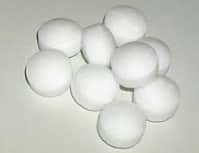 The French word naphtalène came to our language as naphthalene . This is the name given to an aromatic hydrocarbon that arises when a pair of benzene rings condense .
The French word naphtalène came to our language as naphthalene . This is the name given to an aromatic hydrocarbon that arises when a pair of benzene rings condense .
To understand what naphthalene is, therefore, it is necessary to be clear about several notions. A hydrocarbon is a compound that is produced when carbon combines with hydrogen. If the hydrocarbon is derived from benzene, it is classified as aromatic .
Aromatic hydrocarbons such as naphthalene are very stable due to the structure of conjugated double bonds . They are called aromatic since they usually give off an intense smell . Regarding benzene , it is characterized by its ring-like arrangement, with six carbon atoms.
Let's see below the physical properties of naphthalene: its chemical formula is C10H8; Its molecular mass is 128.18 g/mol; Its boiling point is recorded at 218 degrees Celsius; Its melting point is 80 degrees Celsius; Regarding water solubility, it does not apply in this case.
Although naphthalene is not soluble in water, it is soluble in benzene and toluene , among other organic solvents.
Naphthalene, known as white tar or commercially as naphthalene , is a whitish solid. It was discovered in the 19th century as an element derived from the distillation of coal tar .
In 1826 , the English physicist and chemist Michael Faraday (1791-1867) discovered the chemical formula of naphthalene: C10H8 . Four decades later, the German Emil Erlenmeyer postulated the structure of a pair of fused benzene rings .
Naphthalene is usually obtained from the distillation of coal tar, being the component that appears in greatest abundance in this substance. However, naphthalene can also be produced in the context of petroleum refining.
Many people use naphthalene (naphthalene) as a moth repellent . It is important, however, to take into account its toxicity: naphthalene can cause serious damage to health .
Naphthalene has an odor that is impossible to ignore but not necessarily unpleasant. It is a solid that evaporates easily and is also quite flammable. If it is exposed to the open air, it degrades due to contact with some bacteria, sunlight or humidity .
Regarding the sources of naphthalene emissions, it is a substance that can enter the environment through industries, fossil fuels, tobacco or even the handling of wood.
 It is known with certainty that the burning of fossil fuels and wood is the main source of pollution of this substance. Spills that occur during transportation or storage tasks are the most frequent causes of spills into water and soil .
It is known with certainty that the burning of fossil fuels and wood is the main source of pollution of this substance. Spills that occur during transportation or storage tasks are the most frequent causes of spills into water and soil .
Returning to the damage that contact with naphthalene can cause, we must point out that its absorption can occur by ingestion, through the skin or by inhalation of the aerosol. In short-term exposure, effects on the blood may include hemolysis (injury of blood cells).
Prolonged or repeated exposure over a relatively short period of time can lead to anemia or cataracts in the eyes. Ingestion of naphthalene is much more dangerous as it can cause death.
Aquatic organisms are especially susceptible to naphthalene toxicity. Fortunately, when dumped in a local area it degrades in a short time, considerably reducing damage to aquatic life. Outside of water , it adheres strongly to the soil but does not persist considerably in the environment nor accumulates in our tissues.
